Poolish Pizza Dough Recipe (Perfect Crust Super Easy)
Most people are aware of dough pre-ferments, like the kind used to make sourdough and other fermented breads, but did you know the best pizza is often made using pre-ferments as well? It’s true, and one of the most common types of starters used is called “poolish”, which you may have heard of if you’re familiar with Neapolitan style pizza.
Using poolish pizza dough comes with many benefits, including improved taste and texture of the finished crust, although how and when to use it can be confusing at first. Let me show you how I make poolish step by step.
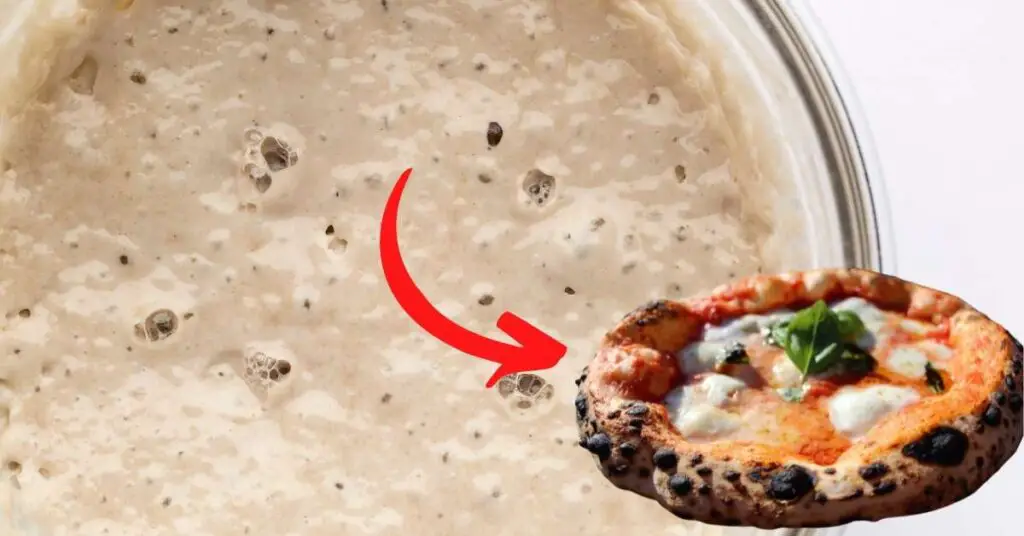
What is poolish Pizza Dough?
Poolish pizza dough is a kind of overnight pre-fermented dough starter used in “indirect” baking instead of dry or fresh yeast. Indirect baking refers to a dough preparation method where (in the case of poolish) baker’s yeast is fermented overnight in a mixture of equal parts water and flour before being incorporated with the rest of the ingredients into the main dough the next day.
Personally, I first became aware of the power of poolish in Ken Forkish’s works. You may have seen Vito Iacopelli’s poolish pizza dough recipe in action in some of his videos. The King Arthur poolish pizza dough recipe is also well known to many. But just in case you haven’t seen or heard of poolish pizza dough before, the following is a brief example of how it works.
A poolish is typically made by combining a small amount of yeast in a mixture of flour and water at 100% hydration level. So, for example, a half teaspoon of dry yeast mixed with 150 grams of water and 150 grams of flour can be cold fermented for 24 hours to create a poolish. That poolish is then combined with the rest of the flour, water, olive oil and salt to create a pizza dough you can use.
If this sounds confusing to you, don’t worry. I’ll tell you exactly how to make a quick poolish pizza dough for yourself further down in this post. As long as you can do some basic addition and subtraction, you don’t even need a poolish pizza dough calculator to the ratio right.
Why use poolish For Pizza Dough?
There are lots of advantages to using an easy poolish pizza dough recipe, namely an improved texture and flavor of the finished bread or pizza crust. Having a premade poolish on hand also gives you the ability to make a fully fermented pizza dough within a few hours instead of the usual 24 hours.
Poolish Pizza Tastes Better In A Pizza Oven
Best Indoor/Outdoor Pizza Ovens Compared
Poolish Pizza Dough tastes better
Because poolish is cold fermented, without salt, for an extended period of time, the flavors and gasses produced by the yeast are different than in a traditionally produced dough, where a larger amount of yeast is fermented at room temperature over a short period of time.
I would describe the flavor profile of a poolish pizza crust as more “mature” than with other methods.
Poolish Pizza Dough Improves Texture
Another benefit of poolish is the improved texture and gluten structure of the dough. When dough ferments, the yeast breaks down its gluten structure little by little as compared to a freshly made dough, which typically has the strongest gluten. Gluten is what gives dough elasticity and helps to create the big air bubbles we love so much.
So, usually, we’re left with the choice of either an unfermented dough with a strong gluten structure, or a slightly tastier fermented dough with a weaker gluten structure.
Poolish, on the other hand, gives us the best of both worlds.
When a prefermented poolish is mixed with fresh flour to make the final dough, we’re left with a crust that has the mature taste of the fermented poolish and the strong gluten structure of a freshly made dough.
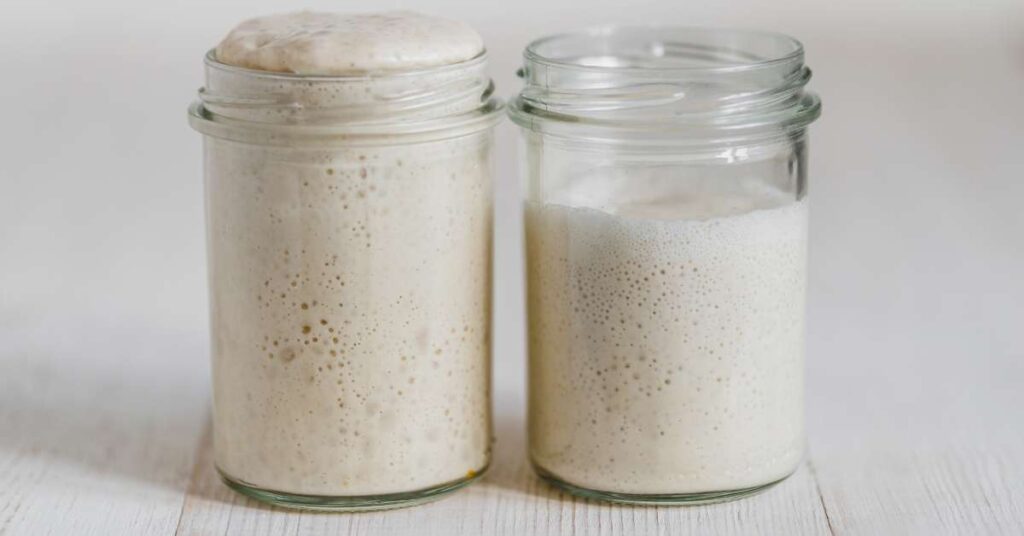
Poolish Pizza Dough Saves Time
A high quality Neapolitan or New York style pizza dough typically takes 24 hours from start until it’s ready to be baked into a pizza. This allows the dough enough time to ferment and develop a rich flavor without having to use too much yeast. The downside to this method, of course, is that you need 24 hours advance notice before you can eat your pizza.
With Poolish, you have a lot more flexibility.
As long as you have a poolish starter made and stored in your fridge, you can make a pizza dough that’s ready to use within a few hours with all the benefits of one that had been fermented for 24 hours or more. Simply add the poolish starter to the rest of the ingredients, knead it, let it proof and you’re good to go.
There is a bit of math involved in terms of how much poolish to use in pizza dough, but we’ll get into that soon.
Poolish vs Direct Method
Poolish is an example of “indirect method” baking, which basically means pre-fermenting a starter dough which is then incorporated with the rest of the ingredients to make the final dough before baking some days later.
By contrast, “direct method” baking refers to the traditional way of preparing dough where you mix all of the ingredients at once. Typically, a dough made with the direct method is kneaded and baked all in the same day, sometimes within only a few hours or less.
Because a dough prepared using the direct method is intended to be used right away, it usually contains much more yeast than a dough, or starter, that’s fermented overnight. For this reason, direct method doughs, while convenient from a time perspective, are less flavorful compared doughs made with the indirect method.
It is possible, however, to ferment a dough made using the direct method to achieve some of the benefits of prefermenting with something like poolish, but we’ll get into this later.
Poolish vs Biga
When it comes to Italian baking, especially pizza dough, poolish and biga are the main kinds of pre-ferments that people typically use. The main difference between poolish and biga is the hydration level. While poolish is a very wet preferment, biga is drier and stiffer.
The choice between poolish and biga is really a matter of preference, but there are a few differences between the two. Because poolish has a much higher hydration level (100%), the final pizza dough will have a soft and puffy texture. Biga, on the other hand, has a much lower hydration level (~50%), which makes the final pizza dough extra puffy but not quite as soft and moist.
I prefer to use poolish because it’s easier to deal with (being a simple 1:1 ratio of flour to water) and because I like a soft and crispy crust. However, many people prefer to use biga because they like an extra puffy crust and the ability to ferment for longer periods of time.
Whichever kind of preferment you choose, you can really up your pizza game by experimenting with both.
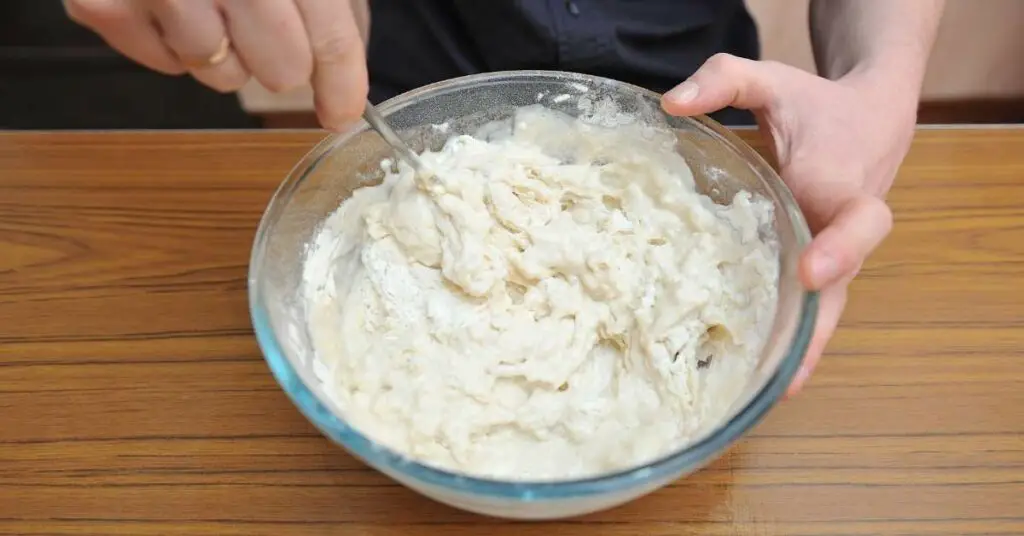
Poolish vs Fermented Dough
A pizza dough made with poolish and a pizza dough that’s been fermented for 24 hours or more have a lot in common. The real difference between the two is that one is made using the direct method of baking and the other with the indirect method of baking.
A fermented dough starts off like any other dough, with flour, water, yeast and salt. It can be kneaded for 10-15 minutes or left to rest such as with the no-knead method. However the dough is made, the key to fermentation is leaving the dough to sit for 16-24 hours so that the yeast has time to mature and the flavor is enhanced.
This is essentially what we accomplish with a poolish, only instead of fermenting the entire dough, we instead ferment just a small portion of it, sometimes as little as 20% of the dough’s total volume.
The benefit of a fermented dough is simplicity – you simply mix the ingredients and leave it to rest, either in the fridge or at room temperature, and wait to use it until the next day. On the other hand, the advantage of using poolish is that your dough still benefits from the mature taste of the pre-ferment, but also has the strength and simplicity of a dough that can be prepared and used in the same day (assuming you already have a poolish on hand).
Poolish vs sourdough starter
Sourdough and poolish are simply two different kinds of pre-ferments used in indirect method baking. Poolish is made by mixing flour, water and common baker’s yeast, while a sourdough starter is made from wild yeast harvested from the flour, your own hands and even the air itself.
The “wild” nature of the yeast used in sourdough starter is what gives sourdough bread its distinctively “sour” flavor. Sourdough starter can also be fed and kept alive for an indefinite period of time (with proper care) – some starters have even been in use for generations.
Compared to sourdough starter, poolish is much shorter lived. The purpose of poolish is to prepare it and use it in the short term, maybe over the course of 2-3 days in the fridge, depending on how cold it is.
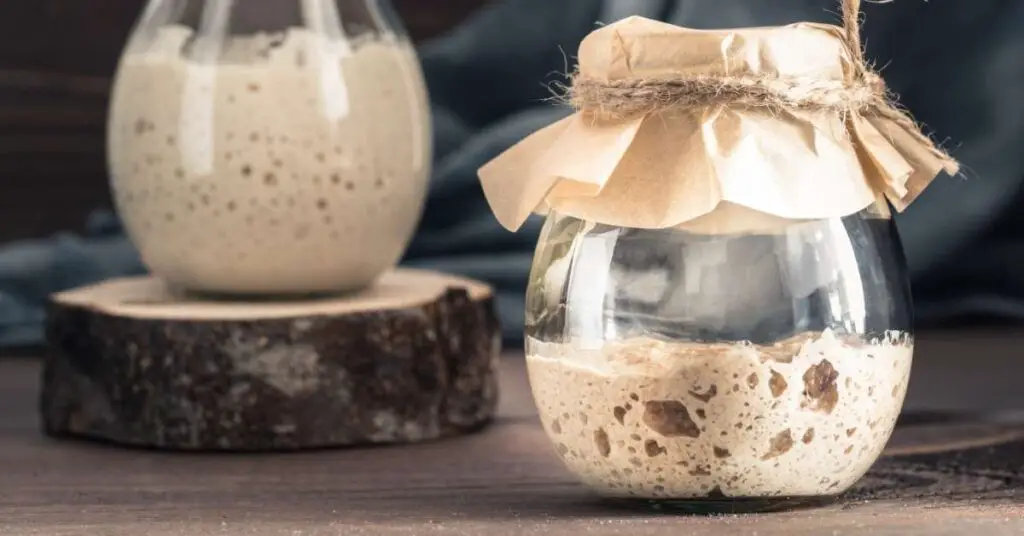
What Is The Poolish Pizza Dough Ratio Formula? Intro to Poolish math
One of the best parts about using poolish is how simple it is to formulate the recipe. There are no baker’s percentages or complex mathematics necessary as poolish is simply a 1:1 ratio of water to flour, or in other words a 100% hydration level, combined with about 0.25% yeast.
For example, to make 600 grams of poolish you would simply mix 300 grams of flour, 300 grams of water and 0.75 grams of active dry yeast (or roughly 1/8 teaspoon). A small amount of honey or sugar can be added to the poolish as well, but this is optional. The poolish then needs to ferment at room temperature for about 1-2 hours and then stored in the refrigerator for another 18-24 hours of cold fermentation.
When the poolish is ready, it needs to be added to the rest of the ingredients of a freshly made dough. In the case of a pizza dough, that means flour, water, salt, and (optionally) honey and olive oil. But using the right amount of poolish for the volume of dough you’re making takes a bit of simple math. In most cases, the poolish should constitute 25-50% of the total volume of the dough.
For example, say you’re making a dough with 1kg of flour and 700ml of water (or 70% hydration). If you want this dough to contain 25% poolish, that equals 250g of poolish to be added (based on 1000g or 1kg of flour). 250 grams of poolish contains 125 grams of water and 125 grams of flour, so you can subtract that from the recipe. You’re left with the following:
- 875 grams of flour (1000 grams minus 125 grams)
- 575 grams of water (700 grams minus 125 grams)
- 3% salt, honey, oil, etc…
With the fermented poolish included in the dough, yeast is no longer necessary. The dough can then be kneaded, divided into balls and left to proof before using. This dough will then be fully fermented, even though it was prepared only a few hours in advance.
How To Make Pizza Dough With Poolish (Recipe)
Note: The recipe ingredients are split between the poolish and the rest of the pizza dough. I’ve added metric and imperial measurements for your convenience, but keep in mind the imperial measurements are rounded to the nearest fraction. For the best results, I recommend buying a kitchen scale and using metric.
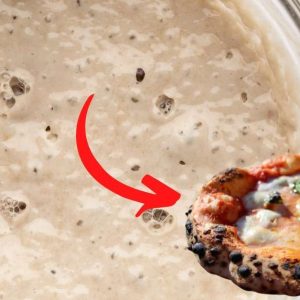
Poolish For Pizza Dough (or bread)
Ingredients
Poolish – Metric
- 100 g Flour (00 or All Purpose)
- 100 ml Water (lukewarm tap is fine)
- .35 g Active dry yeast
- 2 g Honey
Poolish – Imperial
- 3/4 cup Flour (00 or All Purpose)
- 1/2 cup Water (lukewarm tap is fine)
- 1/8 tsp Active dry yeast
- 1/4 tsp Honey
Pizza Dough – Metric (added to poolish)
- 190 g Flour (00 or All Purpose)
- 105 ml Water
- 9 g Salt
- 5 g Honey
- 9 g Extra Virgin Olive Oil (or about 13 grams)
Pizza Dough – Imperial (added to poolish)
- 1 1/2 cup Flour (00 or All Purpose)
- 1/2 cup Water
- 1 1/2 tsp Salt
- 2/3 tsp Honey
- 1/2 tbsp Extra Virgin Olive Oil (or about 13 grams)
Instructions
Poolish Recipe
- Pour room temperature water into a mixing bowl.
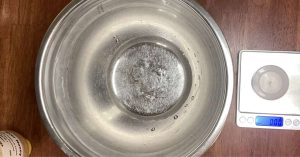
- Add the yeast and honey to the water and mix well.
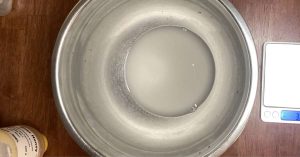
- Add flour to the water and incorporate it fully until you’re left with an extremely wet dough about the consistency of thick pancake batter.
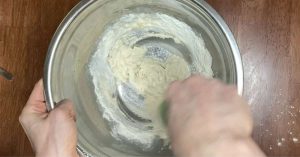
- Transfer the poolish mixture to a resealable container, or a bowl tightly covered in plastic wrap. Let it sit at room temperature for 1 hour, or until you see some yeast activity such as as rising slightly or small bubbles.
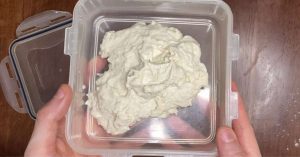
- Place the poolish in the refrigerator to cold ferment overnight.
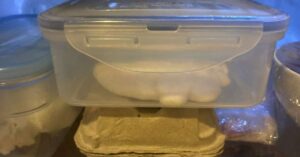
- Depending on how cold your refrigerator is, the poolish will last anywhere from 2-4 days. It can still be used beyond this date, in most cases, but the taste of the crust will change due to the extended fermentation process. This may or may not be a good thing depending on your preferences.
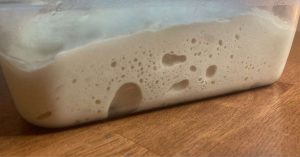
Poolish Pizza Dough Recipe
- Add poolish to mixing bowl.
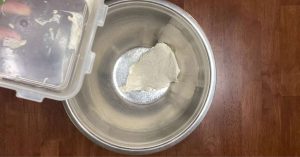
- Add lukewarm water to poolish in mixing bowl.
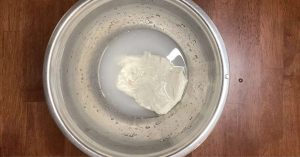
- Mix poolish with water until the poolish has been completely liquified. It should become white and foamy as flour and gas from the poolish is released.
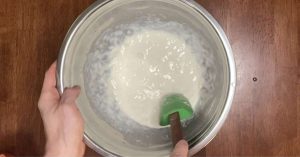
- Add honey and mix well.
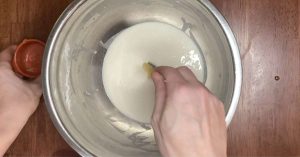
- Mix flour and salt together in separate a bowl and add about half of this mixture to the poolish and water. It helps to add the flour/salt incrementally and mix.
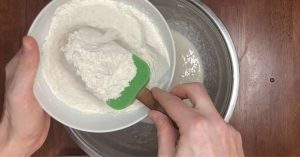
- When half of the flour/salt has been added, add olive oil and mix until it’s fully incorporated.
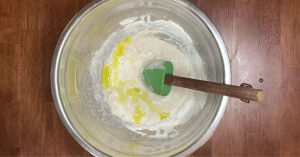
- Add the rest of the flour/salt and mix it until all of the dry ingredients have been hydrated by the wet ingredients. Cover the bowl tightly and let this mixture rest for 15 minutes.
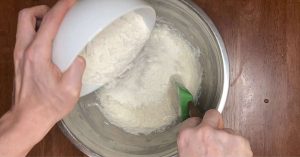
- When 15 minutes have passed, give the dough mixture another quick stir with the spatula. It works best to fold the dough on top of itself several times then form it into the rough shape of a ball, but however you do it should work as well. You should notice that the consistency of the dough is much smoother and less sticky than it was previously, this means the gluten is starting to form.
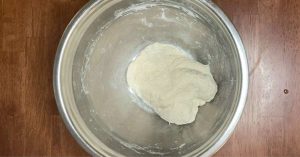
- At this point you have a choice – you can either knead the dough for about 15-20 minutes until the gluten fully forms or you can leave it to rest overnight in the fridge. Both of these methods will encourage gluten formation which is what makes for a good crust. The overnight no-knead method is best in terms of simplicity and the double fermentation effect, but if you need the dough the same day you’ll have to knead it by hand until the dough is elastic and smooth. Personally, I like to let it rest overnight rather than knead it by hand. I find the results are much better and more consistent.
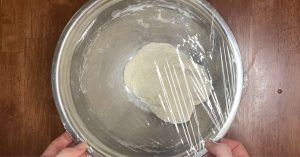
- Tip: If you’ve never kneaded pizza dough before, you can make the process easier (but slightly longer) by kneading for only a few minutes at a time and letting it rest for 15 minutes in between. Each time it rests, the dough will become stronger, less sticky, and easier to work with. When kneading, coat your hands with a (very) small amount of olive oil, lift the dough up and slap it back down onto the counter while folding it over onto itself. Repeat this 3 or 4 times then let it rest for 15 minutes. Repeat this whole process until the dough becomes elastic and smooth then form it into a ball.
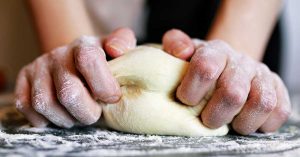
- When the dough has been refrigerated overnight (or kneaded), divide it in half and form each half into a smooth and tight ball. Place the balls onto a lightly oiled pan and cover it gently with plastic wrap so it can expand. Let the balls proof for 3-4 hours at room temperature before shaping them into a pizza, or longer depending on how hot or cold your house is. If you only plan on using 1 of the balls, you can place the other in the fridge and skip the proofing process. If you need help balling and proofing pizza dough, you can find a link to a tutorial at the top of this page.

This pizza dough recipe will give you 2 balls of dough weighing 250 grams each, or enough for 2 Neapolitan sized pizzas. The hydration rate of the finished pizza dough will be approximately 70% – perfect for a home oven. Feel free to split the entire recipe in half if you only want a single ball of dough.
Tip: Honey is added to this recipe to make the crust darker when it comes out of the oven. This is really important especially if you’re using a low temperature home oven. If you find your crust is coming out pale, feel free to add more honey and vice versa if it’s too dark.
Double fermented poolish
To double fermented poolish pizza dough, leave the finished dough ball in the refrigerator overnight or for 16-24 hours. The benefit of double fermentation is an extra fluffy and soft crust while the poolish and yeast work their magic on the the ingredients of the pizza dough. A double fermented pizza dough also requires much less kneading due to the autolyse effect that occurs overnight (just like with a no-knead recipe).
If you need a poolish pizza dough recipe to get started, follow the instructions above.
Related Posts:
- 70% Hydration Pizza Dough Recipe – No More Dry Crust
- 80% Hydration Pizza Dough Recipe – Fluffiest Pizza Crust Ever
- Improved Ooni Pizza Dough Recipe: 65% Hydration, Double Fermented, No-Knead Method
- Domenic’s Detroit Style Pizza Dough Recipe (no-knead)
Related Questions:
Is Poolish Good For Pizza?
Using poolish in your pizza dough, in place of traditional baker’s yeast, is an easy way to get all the benefits of a 24 hour cold fermentation in just a few hours. As a pre-fermented dough starter, poolish provides a more mature flavor profile, similar to a pizzeria, as well as an airier and puffier crust.
What Does Poolish Mean In Pizza Dough?
Poolish in pizza dough is a pre-fermented dough starter similar to starters used in sourdough, which most people are familiar with. Poolish helps to give pizza crust a deeper and more mature flavor profile along with a fluffy, yet still crispy, texture. If you’re a fan of light and airy Neapolitan style pizza, poolish will give you a leg up in reproducing those flavors at home.
Which Is Better For Pizza, Poolish Or Biga?
Both poolish and biga are pre-ferments used in making pizza dough, but there are differences between the two. Poolish is very wet, made using a 100% ratio of water to flour, which makes for a softer, lighter pizza crust. On the other hand, biga is very dry, made with as little as 50% water, which produces a puffier and slightly stiffer pizza crust. In terms of which one is better, biga or poolish, it really is a matter of personal preference. Both are excellent choices if you’re interested in using a pre-ferment in your pizza dough.
Are Poolish And Levain The Same Thing?
Poolish and levain are very similar in principle but a bit different in terms of composition. Levain refers to the part of a sourdough starter you add to a dough, while poolish is a yeasted pre-ferment that you add to a dough. Levain is typically made using wild yeast from the air while poolish is made with traditional baker’s yeast. Both poolish and levain help the dough to rise and improve the flavor of the finished baked product.
How Do You Know When The Poolish Is Ready?
When a poolish is ready to use, it should be covered in small air bubbles and risen slightly. Be careful not to over ferment your poolish, however, as it can grow out of control quite quickly and go bad. The best way to use poolish is by letting it rest at room temperature for about 1 hour to begin the fermentation process then placing it in the refrigerator for 16-24 hours, or overnight. The cold temperatures of the refrigerator will allow the poolish to continue fermenting but at a much slower pace, leading to a better flavor profile and texture when used in a pizza dough.
Can You Over Ferment Poolish?
Because poolish has a relatively high percentage of yeast and no salt, it can over ferment quite easily. For this reason, it’s best to store poolish in a refrigerator, or a very cold room, as soon as the fermentation process has begun (usually after 1 hour or so). The best poolish is cold fermented for 16 to 24 hours before use to ensure the best flavor and texture without the risk of over fermenting.
Why Didn’t My Poolish Rise?
The most common reason for poolish not rising is a dead or underactive yeast. To test the viability of your yeast, place a teaspoon of it in a small bowl of warm water mixed with a teaspoon of sugar. If the yeast does not start to bubble and foam after 15 minutes, it is most likely dead. Another possibility is that your poolish is too cold for the yeast to begin activating – in this case, try leaving the poolish at room temperature for 1-2 hours before putting it in the refrigerator to cold ferment overnight.




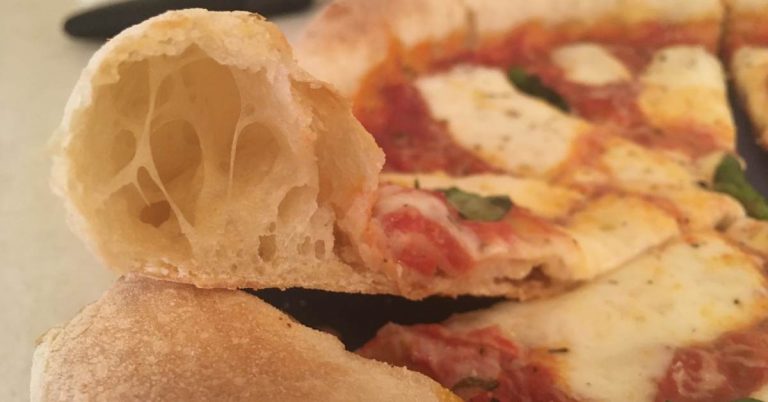
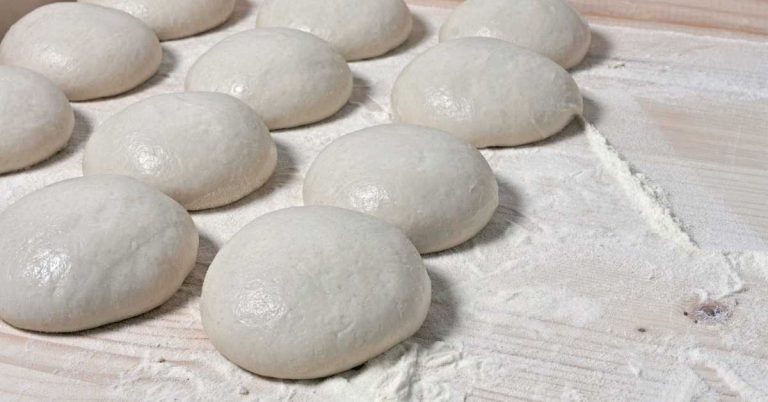


Poolish is an awesome way to combine the deliciousness of overnight fermented pizza dough with the ease of pizza dough made on the same day. Have you tried poolish yet? Let me know in the comments.
Hi,
I would like to use Poolish with your 65% Hydration Ooni pizza dough recipe. Can you share how this can be done. Plane to use is a wood fired oven.
Thanks
Victor
Hey Victor, thanks for the question. If you want to make a poolish pizza dough for your wood-fired pizza oven, you can actually just use this poolish recipe. The only real difference between the two (other than using poolish) is the hydration level. A higher hydration level will benefit any pizza dough, even when using a wood-fired oven.
That said, if you’d like to have lower hydration, easier to work with dough, you can tweak the Ooni 65% Ooni recipe to work with poolish as well. Just make a 150g poolish using the recipe above, then subtract 75g from the water and 75g of flour from the pizza dough recipe, just like I do in the recipe above. If you find that too wet still, you can experiment using only 100g of poolish and subtracting 50g from the water and 50g from the flour.
I’ll post another poolish pizza dough recipe specifically for the Ooni soon, just to make the math a little easier for people.
Good luck!
Hi! Would you keep the honey and oil if want to make this poolish pizza dough for a wood-fired pizza oven? Thnaks!
Good question! It really depends on you, but it’s not strictly necessary since a pizza oven is hot enough to caramelize the crust without any extra sugar. But if you want a darker, crispier wood-fired crust, a little bit of honey works great. Adds a very subtle flavor as well. Good luck!
Thank you for this wonderful website. I am getting into bread making and I was thinking that next time I’d use a poolish.
I’ve been doing an autolyse, having my bread machine do the kneading, and then refrigerating the dough for a slow cold fermentation. I think a poolish would make time management and scheduling much easier.
I then wondered about using a poolish for pizza dough because I haven’t been thrilled with the pizza dough I’ve been making — and your site came up.
Thank you for taking the time to do this. You tell me everything I need to know.
Salt Spring Island, BC
Hi Toby,
Thanks so much for the kind words and I’m happy to know the website has been useful for you.
I think you’re going to love using poolish. It has the taste of a long, slow fermentation with the spring of fresh dough. Don’t be afraid to experiment if it doesn’t work out the first time.
Good luck!
This recipe hasn’t worked for me I’m afraid. Have followed the method to the letter and the resultant dough after the 2nd cold fermentation is very wet. I’ve used the same dried yeast that I always use for my breads and pizza doughs so don’t believe the fault is with the yeast. Any thoughts? Thanks.
Hi Antony, thanks for the question.
This recipe has a high hydration ratio (just under 70%), so it’s going to be relatively wet. If you’re not used to working with wet dough, it can be a bit of a challenge (I know). But all it takes is a few tweaks to how you work with it during the balling and shaping phase.
For starters, you need to coat your hands with a thin layer of olive oil as you quickly and gently pull and fold the dough into a ball. Once proofed, drop the ball into a bowl (or pile) of flour and coat it on all sides to prevent sticking. Carefully shape the dough into a disk and dust it with more flour (sparingly) if it still sticks.
I recommend watching this video (https://youtu.be/o-I-KWEIDvs?t=297) at the time stamp indicated for a demonstration on how to work a high hydration dough into a ball.
Wet dough can be discouraging when it sticks to everything, but don’t give up! Once you get the hang of it, the tenderness of the crust it bakes into will blow you away.
Good luck!
I, too, have followed this recipe to the T. I’ve watched the linked video 10 times and have been trying for two hours to get a smooth, non-sticky dough. Perhaps it’s elevation and temperature, but it doesn’t work for me. I’ve used more olive oil on my hands in the past two hours than I have in the past 50 years. Still just sticks to everything.
Hi Dave,
Working with high hydration dough is difficult, and getting it not to stick to everything while working with it was a challenge for me as well. But thankfully, it’s usually the result of missing or skipping a step somewhere along the way. Are you still at the balling stage, or are you trying to shape the dough for baking?
Did you remember to let the dough rest overnight (or for several hours) after mixing it with the poolish? It’s essentially a brand new dough at that point, so the gluten will still be very weak and sticky.
If you’re still having trouble, I recommend working with the dough directly from the fridge… it’s a bit less sticky when it’s cold. When the poolish is mixed with the rest of the ingredients, let it rest in the fridge overnight. Then take it out, ball it, and let it proof for several hours before baking it. At that point, use flour on the counter and your hands to prevent sticking.
Also, it sounds like you’re using way too much olive oil. All you need is a very thin layer on your hands to act as a buffer. Using too much olive oil will actually have the opposite effect and make it more sticky.
Another tip: when the dough becomes too sticky, working with it more will just make it stickier. You need to cover it back up and let it rest for at least another hour (preferably in the fridge), then come back and try again.
Let me know how it goes and I’ll do my best to help you through any problems. Don’t feel bad though, because like I said, working with high hydration dough is tricky. That’s why this is an advanced recipe. Good luck!
-Dom
I am planning a big pizza party. 50 pizzas on the menu. I need some guidance on the recipe using poolish. I like a larger pie about 285g dough balls. I’m ok with 65-70% hydration. I use an ooni Karu 16. Basically I need to understand the math for this large volume of dough. And how much poolish should I use? Is poolish a % of the total flour weight or total flour and water combined?
Please reach out via email. Thank you!!! Frank
Hi, Frank. Wow, that’s a lot of pizza!
Conventional wisdom says that poolish should be anywhere from 25-50% of the total pizza dough recipe. I usually go for 25-30% because I prefer a less active dough that won’t overgrow if I let it sit at room temperature for a few hours. Ultimately, this is up to you though. The percent is based on the total volume of the dough, so 150g of poolish would be 30% of 500g (150g poolish + 350g water/flour = 500g), plus or minus the oil, salt and honey if you want to be exact (doesn’t really matter). Just subtract the amount of water and flour in the poolish from the total water and flour from the pizza dough recipe and you should be good to go.
So, in your situation, a roughly 30% poolish formulation for a 285g ball of dough would equal around 85g of poolish per dough ball. You can then scale that up for as much dough as you need.
Remember, because poolish ferments longer than the rest of the flour and water, the gluten is weaker than regular dough. So, the higher percentage of poolish you use, the softer the dough will be, which you may or may not want. How long you ferment the dough afterwards plays into this as well.
I recommend experimenting with smaller batches of dough to get the hang of using poolish, and to figure out what percent you prefer, before you make the 50 dough ball batch. Feel free to adjust the amount of yeast to suit your needs as well. For example, if you want a more active, gassy dough (but don’t want to use too much poolish), experiment with adding a bit more yeast to the poolish recipe. Whatever you choose, don’t expect to get it right the first time and don’t be afraid to adjust as needed.
I hope that helps, but if you have any more questions just let me know. Good luck!
-Dom
Thank you Domenic!
So, after determining the amount of poolish I want to use.. What % of the poolish would be the yeast? start with the .25% ? That calculation however is based on the amount of flour only in the poolish correct?
So in my case:
Total Recipe = 14,250g – 8400g flour + 5450g water (65% Hydration)
Poolish = 4,275g -> (30% of 14,250) -> (2138g flour + 2138g water)
Yeast = 5.3g – (.25% of the flour in poolish which = 2138g)
Salt = 252g -> 3% of total flour -> (8400 x .03 = 252)
Honey = ??? Is this also a % of the total flour only?
Thanks again for your time!
No problem!
Looking over your numbers (assuming you’ve done the math correctly), it looks good to me.
.25% yeast is what I use, so it should work fine for you. Keep in mind though (like I mentioned before), I like to use a minimal amount of yeast to keep the dough from overgrowing. So, depending on the temperature of your kitchen and how long you leave the dough to proof at room temperature, etc., you might want to use more or less. Generally speaking, the more yeast, honey, time, and heat, the faster the yeast will grow. Too much yeast activity and the dough will blow out, lose its fluffiness, and taste funny. Too little yeast and the dough will cook into a dense, flat crust with a floury taste. So it’s all a balancing act. This is why I really recommend experimenting with a smaller batch, then multiplying it by 50 when you like the results.
As for honey, I aim for 1-2% of the total volume. Since you’re cooking in a high temperature pizza oven, honey isn’t as important for caramelizing the crust, but I like to use it to give the small amount of yeast a head-start. Same goes for olive oil… it’s not strictly necessary in a pizza oven, but I like to use around 1-2% to make keep the dough smooth and easy to worth with. For what it’s worth, traditional Neapolitan pizza dough doesn’t usually contain honey or olive oil, so ultimately it’s a matter of personal preference.
Also, don’t neglect to plan for how you’re going to store and proof 50 balls of dough. The recipe is an important part of making a good pizza, but how you ball and handle the dough afterwards is equally important.
Practice makes perfect, so don’t expect to get it right on the first try. Cooking for such a large crowd has unique challenges as well. Good luck!
Thank you Domenic! I plan to cold ferment the poolish a good 16-24 hours. Next day make the 50ish dough balls. Then I’m going to cold ferment the balls overnight and remain in the fridge until a couple hours before I start cooking. I have a lot to do that same day so I can’t be making dough balls the same (second) day. Based on this, would you suggest any changes to ingredients to better support the second cold fermentation plan?
Hey Frank. It seems like you have a good handle on this and I have faith that it will work out for you. Just remember that the longer the dough ferments, the softer and weaker the gluten becomes. If I have a dough ball fermenting for multiple days, I usually reform the ball straight out of the fridge then let it rest for a few hours. This resets the gluten structure and gives the dough back some of its spring.
You don’t have to do this, but be aware that the dough will be more delicate if the ball has been sitting in the fridge for 12 hours or more (or even just overnight). You can still make an amazing pizza with a delicate dough, you just have to be extra careful during the shaping process. Press very gently, use plenty of semolina and the dough will almost shape itself without losing too much air.
You might not need to change anything, but you could consider lowering the hydration to 55-60% to stiffen things up (the crust will be drier though). If you’re adding oil, maybe use 1/2 as much since that softens the dough as well. Definitely don’t overproof either, especially if you live in a hot climate.
Hopefully that helps and don’t forget to test things out first. Good luck!
Once your poolish is done and before you incorporate it to the flour, can you freeze, if not, when is the best time to freeze your pizza dough, thanks for your response
Hi Johanne. You can freeze the poolish after letting it sit at room temperature for an hour, but for me it isn’t worth freezing because it’s so simple to make and will need time to thaw anyways. But of course, it’s up to you. As for when to freeze the dough, there are several methods, but I prefer doing it just after the dough balls have been proofed. When you’re ready to use one, let it thaw until it reaches room temperature and you should be good to go. Good luck!
Can I use Flour 00 or it’s best to use regular white flour. Thanks
00 flour is ideal for making pizza, especially if it’s high in protein and has a high water absorption rate. I recommend using Caputo 00 “Chef’s” flour for long ferments, including poolish. For links to some flours I recommend, check out my post on that here:
https://www.myhouseofpizza.com/what-you-need-to-make-pizza-at-home/
That said, you can also use all-purpose flour if that’s what you have available, but the crust won’t be as tender compared to 00.
If I’m doing double-fermentation, do I create 2 balls and THEN put them in the fridge, or keep it as one ball and divide them the next day and let them proof for a couple hours before shaping?
Hi Steven. Good question. It actually doesn’t really matter if you create the balls first or last, they will ferment just the same. However, gluten relaxes over time, so the dough balls will be very delicate after multiple days of fermentation and may not rise as much in the oven. For this reason, I usually recommend forming the dough balls either the same day you plan on using them or the night before (if you won’t have time). You can always reform the dough balls if they’re already made as well. This will reset the gluten in the dough and help you get a nice puffy crust. Good luck!
What is the minimal amount of time to ferment the polish before using it.
Hi Franca, thanks for the question. There really isn’t a set minimal amount of time that poolish needs to ferment before using it, however I generally let my poolish sit at room temperature for 1-2 hours, then let it rest in the fridge overnight. I think 16-24 hours is the sweet spot when it comes to fermenting poolish starters, but up to 48 hours can work as well. Hope that helps!
Hey, thanks for the recipe Domenic.
How long should I let the poolish sit before putting it in the fridge?
Hey Jim! Thanks for the question.
I like to let poolish sit at room temperature until I start to see some activity in the form of bubbles and a little bit of expansion in size. This is why I generally use a clear plastic container so I can see the little air bubbles forming underneath (they look like little dark dots).
For me, this generally takes about 30 minutes, but if you’re house is cold it can take longer. Similarly, if your house is very warm, it can take as little as 15 minutes.
If you’re unsure, err on the side of less time out of the fridge because it can negatively affect the taste of the crust if you let it over ferment at room temperature.
Remember, poolish has added sugar (honey) but no salt, which means the yeast gets to work very quickly. This is why you want to get it in the fridge as soon as it activates to slow down the process and get those mature flavors when it bakes.
I hope that was helpful!
Awesome recipe, Domenic. Thanks for spelling everything out so clearly.
One question: can I use bread flour for the poolish then another kind of flour (ap or 00) for the pizza dough itself? Or does it all have to be the same? Thanks again.
Hi Gordie. So glad you liked the recipe! You can absolutely use 100% bread flour for your poolish. In fact, bread flour’s extra strength makes it a great choice for when you plan on storing the poolish for multiple days before using it. I often use a 100% bread flour poolish with a 50/50 bread/00 flour base dough for New York style and it always turns out great everytime.
Can I use instant yeast instead of active dry yeast? If so, what changes are required?
Hey Peter. Absolutely! In most cases, you can substitute instant dry yeast for active dry yeast 1:1. But keep in mind, instant dry yeast is stronger, so if you find the dough is too active, you might want to reduce the amount of instant yeast by about 20%. Personally, I’ve never found it necessary to change up the amounts, especially when using minimal amounts of yeast like I recommend in my recipes. Good luck!
Hi how can I bake this in a regular oven?
Thanks for the question! You can easily bake this in a regular oven using a pizza pan, a pizza stone/steel, or even just a sheet of parchment paper placed on the middle rack. A pizza steel will get you the best results though!
Just be sure to ball the dough and let it proof fully before stretching it out.
Any other questions, let me know. Enjoy!